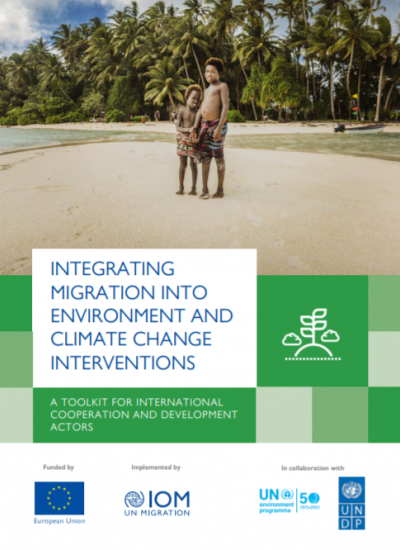Migration is a response to assorted ‘drivers’, whether they be social, political or economic. Climate change interacts with these drivers by acting as an accelerator or a multiplier depending on how sensitive the drivers are to climate change. As a result, the nexus between migration, environment and climate change is highly complex. Migration flows impacted by climate change are commonly referred to under the umbrella term of environmental migration. Environmental migration can be forced or voluntary, temporary or permanent, internal or international, not forgetting the forced immobility of the most vulnerable populations, trapped by the impacts of environmental changes.
Environmental migration includes many forms of migration such as disaster displacement, planned relocation, circular or seasonal migration and labour migration to name but a few. For example, communities can be displaced due to extreme weather events and natural hazards or may evacuate ahead of a disaster. Erratic temperatures induced by climate change can disrupt the livelihoods and traditional routes of pastoralists due to the impacts on winter and summer grazing pastures. Communities impacted by climate change may also resort to temporary and/or seasonal labour migration to diversify livelihood opportunities or, for some Small Island Development States (SIDS), sea level rise may make land uninhabitable and may require planned relocation initiatives. The adverse impacts of the effects of climate change are disproportionately high in developing and least developed countries as well as among the poor and marginalized social groups.
But the linkages between the environment, climate change sector and migration don’t stop there, they are context-specific but also often cross-cutting with other sector areas such as:
- Employment: The development of initiatives to decouple economic growth from fossil fuels and resource-extractive industries, and the shift to circular and green economies, is a growing global priority. As sectors and enterprises are greened, many low- and high-skilled migrants that are employed in resource dependent sectors (industry, agriculture, construction, waste management) will require up-/re-skilling and social protection. (In line with SDGs 1, 2, 5, 7, 8, 9, 10)
- Governance: The impacts of climate change can lead to a loss of biodiversity, disrupt ecosystem services, and reduce natural resources which, in turn, can increase demand for natural resources and exacerbate communal tensions. This can impact the drivers and experiences of migration. Well-managed ecosystem services include both host communities and migrants (including pastoralists) in decision making processes plus an awareness of pre-existing tensions relating to natural resource management, as well as considering the impacts of conservation projects on local and mobile populations so as not to intensify tensions or create new challenges. (In line with SDGs 6, 13, 14, 15, 16)
- Rural development: The effects of climate change are often felt most severely in rural areas. Natural resource-dependent livelihoods, such as farming, fishing and forestry are severely impacted by challenges from changing ecosystems. This often leads to internal and international, circular and urban migration. Key drivers of migration from rural to urban areas include poverty, vulnerability, food insecurity, lack of employment and more. Many of these drivers are exacerbated by climate change which can for example accelerate and multiply the depletion and degradation of natural resources, decline in crop yields and loss of agrobiodiversity. (In line with SDGs 1,2, 14, 15)
- Urban development: Climate migration occurs against a demographic backdrop of growing populations and rapid urbanization in many countries, where migration and urbanization are quickly increasing even before taking into account climate change. Migrants should be included in all targets relating to urban disaster risk reduction and management, as they are often more vulnerable to disasters in urban areas. The inclusion of migrants and displaced populations in urban initiatives to address air, land and water pollution is also critical as migrant and marginalised groups are often amongst the most vulnerable. (In line with SDGs 3, 11 and 13)
- Private sector development/trade: The private sector, including industry and employer associations, are often key partners in responding to climate change and its relationship to migration. The private sector can support reskilling of migrant workers and facilitate low- and high-skilled migration in the transition to a green economy, hire circular/seasonal migrants from climate affected areas and adapt products to support migration and climate change adaptation, resilience and recovery from disaster development, among its many other roles. (In line with SDGs 7, 8, 9, 12)
